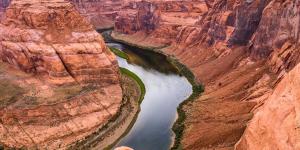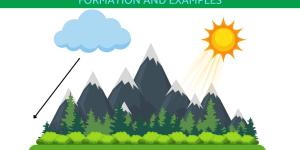What Is Halocline in Oceanography?


The halocline is zone within a body of water which has a highly pronounced salinity gradient. It is characterized by having an abrupt change of salinity as we go deeper into the body of water, creating distinct transition zones which affect water density and stratification. Since these characteristics can change, we are able to find different types of haloclines studied within oceanography, i.e. the study of seas and oceans. These include permanent halocline, seasonal halocline, upwelling halocline, mixing halocline and others. The halocline is often compared to other strata of oceans, especially the thermocline.
At thedailyECO, we find out what is the halocline in oceanography? In addition to providing a definition, we learn about why it is important in the study of oceans, the different types of halocline and how it compares to other zones within oceanic waters.
What is the halocline?
A basic definition of the halocline is a layer in a body of water in which there is a rapid change in salinity as we descended deeper. The abrupt change in salt concentration creates a distinctive transition zone between layers of water. While they may look similar, these layers have different physical and chemical properties which allow such distinction. Although haloclines are most often studied in oceanography, their presence is not limited to marine environments.
To better understand the halocline, it is essential to understand the concept of salinity, i.e. the amount of salts dissolved in water as a solution. Salinity can vary due to different factors, including evaporation, precipitation, snowmelt and introduction of fresh water from rivers or streams. In the case of the halocline, the abrupt transition is generally due to a combination of these factors.
When salinity changes drastically in a body of water, physical properties also undergo notable variations. For example, the density of water is closely related to its salinity. In the halocline layer, this abrupt change in density can give rise to phenomena such as stratification. Stratification refers to the formation of distinct layers based on density, with the halocline playing a key role in this process.
The halocline not only affects the physical properties of water, but also has important implications for marine life. Many species of aquatic organisms are adapted to specific salinity conditions. The presence of a halocline can influence their distribution and behavior. Some species may prefer waters with a specific salinity and will only be found in specific layers of water where the halocline creates optimal conditions for their survival.
We provide a more general overview of marine conditions with our article on what are sea or ocean waters?

Where is the halocline located?
The presence of halocline varies depending on the type of water body and specific geographical conditions. As we have stated, it is most commonly studied in oceanography, but it not exclusive to marine environments. For this reason, we can look at where the halocline is located in different bodies of water:
- Oceans: the halocline is most evident in tropical and subtropical regions where evaporation is high. This evaporation causes salinity to increase significantly in the upper layers of the water. Evaporation is high due to elevated temperatures and intense solar radiation which favor this process, leaving behind the salts dissolved on the surface.
- Lakes and lagoons: can also have haloclines, especially in those that experience seasonal fluctuations in their water level. Times of drought can increase salinity, creating a temporary halocline. Additionally, some saline lakes (such as the Dead Sea) are known to have very pronounced haloclines due to their high concentration of salts. Learn about the difference between lakes and lagoons in our related guide.
- Estuaries: they are favorable sites for the formation of haloclines. The mixing of fresh water flowing from rivers with oceanic salt water creates notable salinity gradients. At the interface between these two water sources, the halocline forms. Estuaries are often compared to river deltas, but the currents of rivers make it more difficult to form a distinct halocline.
- Polar regions: although not as pronounced as in tropical regions, the halocline can also be found in the oceans of polar regions. Low temperatures and the presence of ice can affect the salinity of the water in these seas, creating conditions conducive to the formation of halocline in the subsurface layers.
The halocline is not static and can undergo changes over time and in response to climatic and seasonal factors. Understand these factors with our article on the difference between climate and weather.
Types of halocline
As we have already stated, there are several different types of halocline. These are classified according to the specific conditions which cause variations in the water's salinity. Some of the most common types of halocline include:
- Permanent halocline: this halocline persists throughout the year and is found in regions where climatic conditions are conducive to a constant salinity on the water surface. These conditions include high levels of evaporation with low levels of precipitation. Tropical oceans are examples of places where permanent haloclines are most noticeable.
- Seasonal halocline: unlike permanent haloclines, seasonal haloclines undergo changes throughout the year. This type of halocline is more common in regions with well-defined climatic seasons. During periods of high evaporation, salinity increases to create a steeper halocline, while salinity decreases during times of heavy rain.
- Upwelling halocline: forms when deeper, colder waters which are rich in nutrients and generally more saline, rise toward the surface. This phenomenon is common in areas where prevailing winds push surface layers of water away from the coast, allowing deeper water to rise and generate a halocline.
- Mixing halocline: occurs when two masses of water with different salinities meet and mix. This type of halocline is common in estuaries and river mouths where fresh river waters meet salty ocean waters, generating steep salinity gradients.
- Seasonal halocline in lakes: temporary haloclines occur most often in lakes that experience significant seasonal changes. During the summer, evaporation can increase salinity at the lake surface, creating a halocline that disappears or decreases during periods of rain or snowmelt.
- Halocline in saline lakes: saline lakes, such as the Dead Sea, are prone to extremely pronounced haloclines due to their high concentration of salts. In these bodies of water, the halocline can extend throughout a large portion of the water column and have a significant impact on aquatic life. Find out more with our guide to salt water lakes.

Differences between halocline and thermocline
While the halocline focuses on changes in water salinity, the thermocline is related to variations in temperature. The formation of the halocline is related to changes in the concentration of salts dissolved in water, which can be due to factors such as evaporation, precipitation and the influx of fresh water from terrestrial sources. In contrast, the thermocline forms due to temperature variations in water, usually caused by the uneven absorption of solar radiation at the water surface and the resulting thermal distribution.
Finally, the halocline can be both permanent and seasonal, depending on climatic conditions and geographic location. The thermocline tends to be more pronounced during warm seasons and can dissipate or weaken during colder periods.
Now that you know what the halocline is and where it is located, we recommend you read this article on what is the difference between an ocean and a sea?
If you want to read similar articles to What Is Halocline in Oceanography?, we recommend you visit our Environment (other) category.







